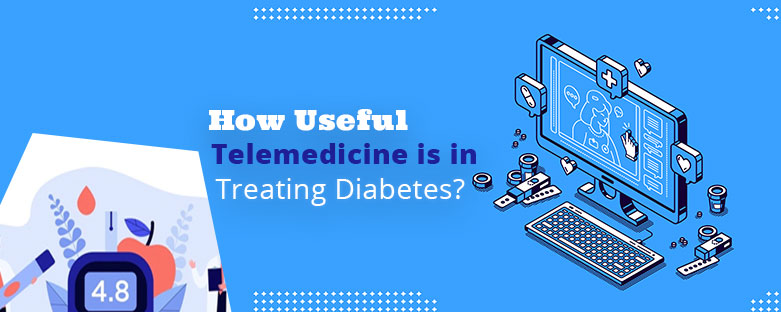How does Telemedicine useful in treating diabetes?
Telemedicine app development has started to transform the healthcare industry. Telemedicine software development is now the primary goal of healthcare organizations wishing to provide patients with healthcare facilities from a distance. in this article How does telemedicine useful for diabetes?
Type 1 and type 2 diabetes treatment includes a steadfast dedication to controlling blood sugar, healthy eating, daily exercise, and occasionally injections of medication or insulin. The rigors of handling the situation can become daunting. It should come as no surprise that people with diabetes are at least twice as likely as non-diabetics to suffer from
Telemedicine software is a perfect option when it comes to routine checkups or dealing with patients who have trouble getting to their appointments either through a lack of transportation options or mobility issues. In mitigating the spread of infection and protecting your patients from virus exposure, it has also become an important factor.
Telemedicine is treating a patient without the physician meeting the patient in person. By using live images, audio, and also transmitted to the patients their diagnosis
Diabetes is a disease in the United States that affects more than 30 million individuals, about 10 percent of the population as a whole. It is also the seventh leading cause of death and does not exhibit signs of slowing down. Diabetes care has come a long way from the days when doctors would prescribe extreme diets limited by calories. Important progress in care has now been made, and most people living with diabetes will lead normal lives.
By allowing treatment to be provided by on-demand and scheduled appointments, clinicians can better serve their diabetic patients through next-gen telemedicine platforms, offering improved access to convenient care.
Next-gen telemedicine platforms can help provider’s better serve their diabetic patients by enabling care to be delivered via on-demand and scheduled visits, providing increased access to convenient care.
Compared to other diseases, telemedicine is particularly appropriate for treating diabetes, since diabetes requires interpretation and predetermined responses to several types of data that can be assessed by the patient at home.
Studies focusing on the advantages of telemedicine for diabetes found that the latter could be improved in patients who were treated by video and who had impaired glycemic control. Another research was performed on patients with type 1 diabetes with average blood glucose (sugar) levels below 8% who received several daily self-administering insulin shots. The findings for patients who received telemedicine-only therapy were close to those who interacted with health care providers in person.
One of the key advantages of telemedicine for diabetics, the researchers said, was its potential to reduce healthcare costs. Medicine is not aimed at removing the need for face-to-face visits, but rather at reducing the need for them. In this way, it is possible to save time and resources, and those who lack the incentive to attend visits physically will enjoy the ease of being helped from home.
In particular, due to the high risk of poor prognosis, its use in diabetes and complication monitoring has been surprisingly growing. New evidence and technical advances in the application of telemedicine for diabetes retinopathy (DR) have shown effectiveness and utility in screening.
Because diabetes is a chronic illness that needs patients to routinely seek treatment from physicians, it makes the disorder a perfect case for the benefits of telemedicine. Regular and effective monitoring and treatment is important for diabetes. The logistical complexities of daily office visits can often prove difficult, and the individual with diabetes flounders in the gap of in-office treatment and at-home management. It is precisely in this void that telemedicine shines.
The Promise of Technology
For patients with type 2 diabetes, proper diabetes management is important for both patient wellbeing and successful healthcare spending. Technological innovations have the ability to enhance the quality of care and expand access to healthcare services for patients with type 2 diabetes. Diabetes self-management is strongly related to behavioral improvements, which can be constantly tracked on telehealth platforms.
Benefits of Telemedicine in Managing the Diabetes Epidemic
When it comes to treating diabetes, telemedicine has some easy and clinically responsible benefits:
- Support for lifestyle modifications:
A study showed that with the help of digital health resources, patients can be allowed to lose weight, reduce blood pressure, and engage in healthier behavior to curb diabetes.
- Engagement of patients:
Commitment to care may be particularly burdensome for rural patients. Providing a telemedical experience will provide remote patients with digital access from their own homes to medical support, thus helping to remove local barriers to treatment.
- Consistent monitoring:
Consistent monitoring includes diabetes. Telehealth will allow digital monitoring round-the-clock, offering clinicians a 24-hour profile and a clearer understanding of the condition of the patient.
- Cost control:
Diabetes causes patients and our healthcare system a staggering economic burden. In 2017, the American Diabetes Association reported that the cost of diagnosed diabetes in the U.S. reached $327 billion, losing another $90 billion in lost productivity. If you assume our healthcare system is strained now and that the costs are exacerbated, add another 40 to 50 million people with diabetes into the mix and we would be in really deep trouble. The ability to access rural people via telemedicine will theoretically help curb these figures.
- Treatment for Depression:
People with diabetes are at least twice as likely as non-diabetics to suffer from depression. Low sugar in the blood causes feelings of lethargy. This can increase unhealthy nutrition, lack of exercise, and general self-neglect, which between diabetes and depression can establish a cyclical existence. Via telemedicine for diabetes, depression may also be handled digitally.




